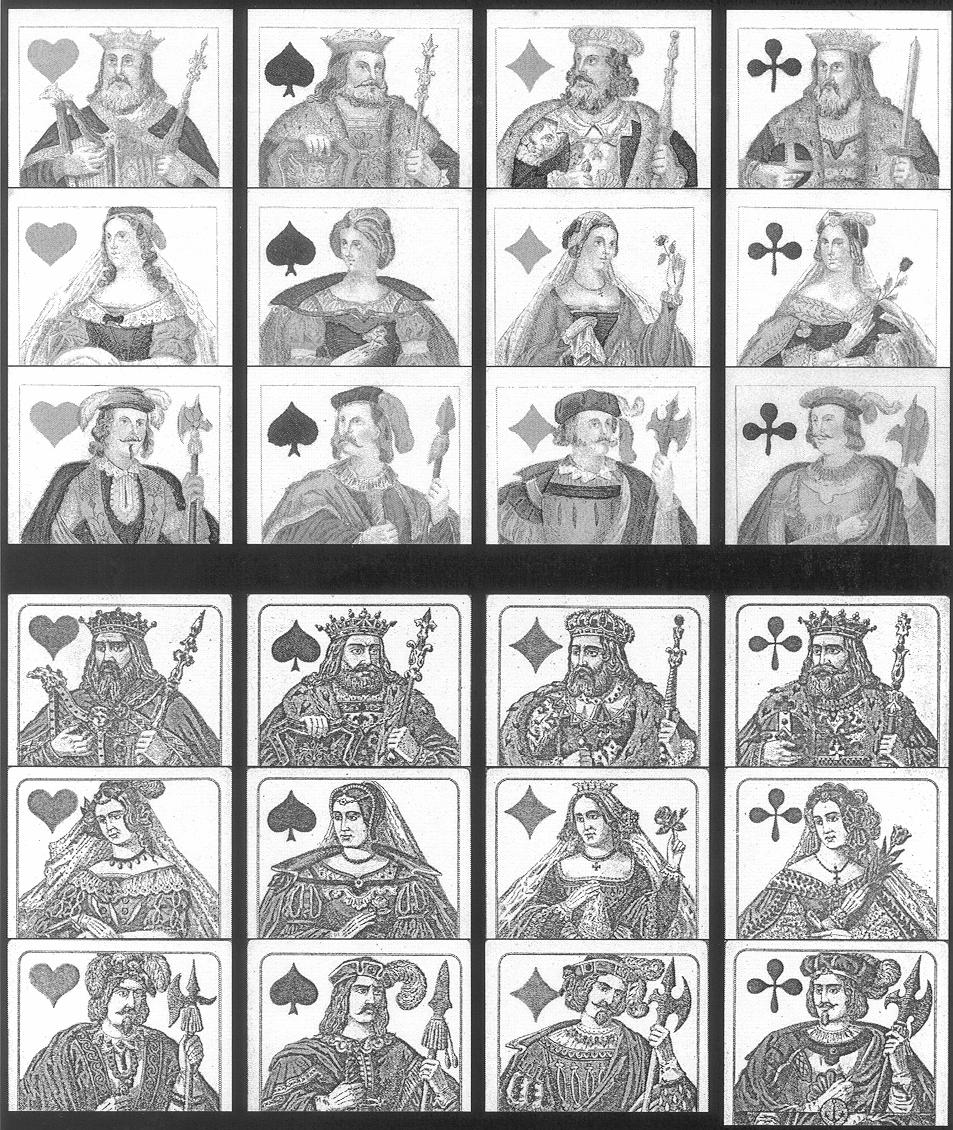

| Suit System: | F |
| Recommended Name: | no recommended name. |
Formerly labelled F-1.531 and XP5/17 (XP for eXpatriate Paris). The notation 5/17 was intended to indicate its position as a transitional pattern between XP5 [IPCS #72] and XP17 [IPCS #78].
Known examples of this pattern are not numerous, but they are all different
from one another. All are probably German. One, formerly owned by Messrs
Stanley Gibbons, was illustrated in JPCS VIII/2 and is clearly closely related
to its progenitor (F-1.53, XP5) and its descendant (F-1.531, XP17) shown
there. This anonymous pack had scenic aces of Francfort a/M, Paris, New York
and Veracruz. Sylvia Mann owned an example with similar Kings and Jacks but
Queens closer to those of XP5 [IPCS #72], and scenic aces showing Heidelberg
and various named landmarks there. She dated this pack as c.1855.
Two more examples with similar Queens and Jacks and 19th-century German tax-stamps
are in a private collection (one has the trademark of Frommann & Bünte).
All these examples have stencil colouring. Another example, colour-printed,
carries the anchor trademark of Frommann & Morian (c.1894) on the J![]() . In this design, the traditional sword held by K
. In this design, the traditional sword held by K![]() in the other examples is replaced by a sceptre. The Queens and Jacks are
different again. This example may date from a time after the creation of
XP17 [IPCS #78], which was produced by several Turnhout makers.
in the other examples is replaced by a sceptre. The Queens and Jacks are
different again. This example may date from a time after the creation of
XP17 [IPCS #78], which was produced by several Turnhout makers.
Usual XP format (i.e. with a horizontal dividing line). As usual it is
the four Kings that carry the distinguishing features of the pattern. In
the Frommann & Morian version, all Kings carry sceptres, but in the others
the K![]() holds a sword (and the orb of the Paris pattern "Charles"). The harp, held in this pattern by K
holds a sword (and the orb of the Paris pattern "Charles"). The harp, held in this pattern by K![]() , is of an unfamiliar and extraordinary shape, apparently having two parallel straight sides (each topped with a head). The K
, is of an unfamiliar and extraordinary shape, apparently having two parallel straight sides (each topped with a head). The K![]() wears an arched crown, and has a lion-mask on one shoulder; he is not in profile. The shield, held in this pattern by K
wears an arched crown, and has a lion-mask on one shoulder; he is not in profile. The shield, held in this pattern by K![]() , has the angular top and winged face of the progenitor XP5 [IPCS #72].
, has the angular top and winged face of the progenitor XP5 [IPCS #72].
The Queens are not royal, but ladies wearing various types of headpiece,
three or four of them with veils hanging from the back. The Queen holding
a tulip (Q![]() ) is not in profile; she holds the flower in her right hand across her left shoulder.
) is not in profile; she holds the flower in her right hand across her left shoulder.
Three of the Jacks hold halberds, the other (J![]() ) a tasselled spear. The J
) a tasselled spear. The J![]() is holding the edge of his cloak like the J
is holding the edge of his cloak like the J![]() of the old Paris pattern. Suit-swapping does not seem to happen in the known examples, despite some variation in the figures.
of the old Paris pattern. Suit-swapping does not seem to happen in the known examples, despite some variation in the figures.
The two halves of the court cards are often coloured differently.
King, Queen. Jack and numerals; 52 or 32 cards. Some 52-card packs with scenic aces, as described above.
Apart from the illustration of the four Kings of the Gibbons example in JPCS VIII/2, there are no other illustrations known.

| Top three rows: | Anonymous maker, with Hamburg tax-stamp 1863-1874. |
| Bottom three rows: | Frommann & Morian, c.1894, from the collection of John Berry. |
| The International Playing-Card Society | 8/2001 JB |